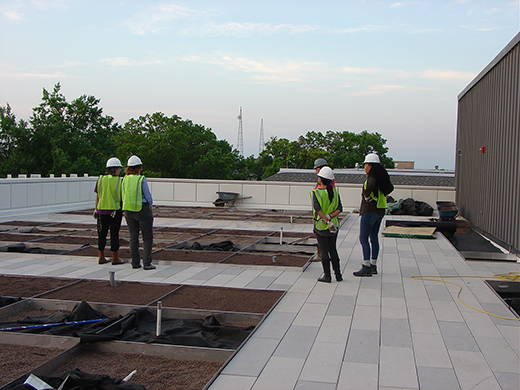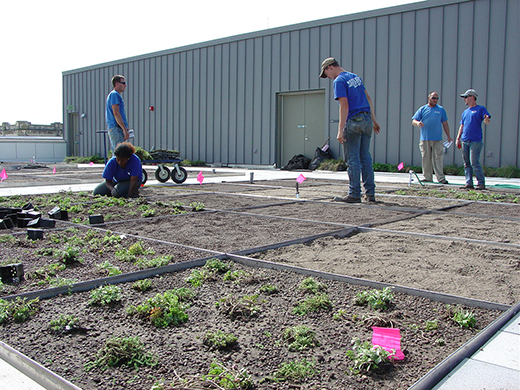KSU Architecture, Planning, and Design Experimental Green Roof
Description
The APDesign Experimental Green Roof (APD-EGR) was constructed during summer and fall 2017 and contains extensive (~2.5-4.5-inch deep), semi-intensive (~5.0-6.5-inch deep), and intensive (~7.0-9.0-inch deep) beds (commonly called 4, 6 and 8 beds). The APD-EGR is located on top of Regnier Hall with limited access through the Ekdahl Conference Room. This roof is expected to be the most scientifically studied green roof at K-State. Research started in 2018, and many sensors and instruments were installed to better understand surface and sub-surface temperatures, soil moisture dynamics, and microclimatic variations through time. It is hoped that research on this roof will improve understanding for green roof vegetation, substrate, or soil, types, and substrate depths for green roofs in the Flint Hills.

Design and Installation
On this roof, there are three green roof beds, each having three different substrate depths: 4, 6 and 8 inches. Each of these beds contain two different substrate types: Kansas BuildEx and Rooflite Extensive MC. The BuildEx has added sand, worm castings and peat moss mixed into the expanded shale. In each substrate are three plant species mixes: an all Sedums mix, a Sedum and native grasses mix, and a native grasses and forbs mix. Each approximately 1.5-square-meter plot originally contained six different species and 18 total plants. Each bed has 24 plots. This detailed design, completed with the help of a statistician, will help the research team better understand how the different types of vegetation respond to the two different types of substrate and which depth plant species prefer.

Research Intentions and Findings
This green roof provides an excellent opportunity to understand what vegetation works best on a flat green roof in the Flint Hills ecoregion. Long-term experimental studies of mixed-species green roof systems are being conducted to improve the design, implementation and management of green roofs in the Flint Hills ecoregion and other parts of the world with similar climates. This will be done by studying the relationships between micro-meteorological variables, the two regionally-supplied substrates, and mixed-species performance over time. In March 2018, our team began investigating the relationships between different subsurface variables: substrate type, depth, and nutrients, changing moisture levels and temperature dynamics. METER Group Inc. equipment is being used on these green roofs, including five weather station sensors, 24 soil moisture and temperature sensors, four RT-1 soil temperature sensors and eight EM50-G dataloggers. Additional sub-surfface soil moisture and temperature sensors were added in July 2019 in the all-sedum plots, and surface temperature sensors were added in 2020 in selected 4-inch and 8-inch plots.
We are also documenting the survival and health of individual species, and changes in vegetative coverage. Selected first-year data has been published -- https://doi.org/10.1016/j.scitotenv.2019.134089 -- so take a look!
Additional research findings (including initial findings on substrate microbiology) have been added to our resources page, and will be updated year-to-year.
APDesign Experimental Green Roof
Size: Each section/bed is 51 square meters or 550 square feet, totaling 153 square meters or 1,650 square feet.
Access: Restricted.
Installation: July to December 2017 (green roof system and initial plantings); March-June 2018 (weather station; initial sensors; replacement plants).
Design Team:
Lead Conceptual Designer: Lee R. Skabelund.
Detailed Design and Construction Documents: Confluence, BNIM & Ennead.
Implementation and Suppliers:
Contractors: J.E. Dunn, general; and Blueville Nursery, green roof system.
Green Roof System and Drainage Layer: Carlisle adjustable aluminum edging with EDPM tape; Firestone Skyscape 1/2” by 4’ by 50’ drainage panel.
Substrate Suppliers: Rooflite-Missouri Organics; BuildEx-Blueville Nursery.
Sedum Plant Supplier: Blueville Nursery and Bluebird Nursery.
Native Prairie Grasses and Forbs Supplier: Applied Ecological Services and Blueville Nursery.
Waterproofing Material: Diamond Roofing.
Research Team: Lee R. Skabelund, Allyssa Decker, Priyasha Shrestha, Lekhon Alam, Yuting Gao, Trisha Moore, Mary Knapp, Marybeth Kirkham, Gerard Kluitenberg, Charles Rice and Carol Baldwin. April 2018-April 2019 Visiting Scholar Jialin Liu (Southwest University, CHINA).
Research Funding: The research team appreciates the generous financial support from the Mary K. Jarvis Endowment (K-State landscape architecture program), K-State University Small Research Grant funds, and Buildex.
Research Equipment Suppliers & Support: METER Group Inc.